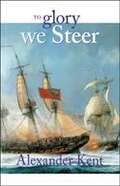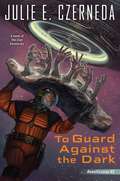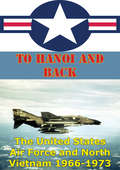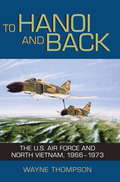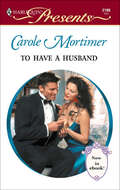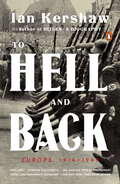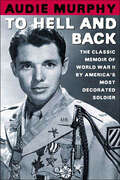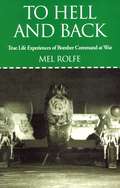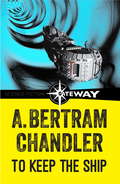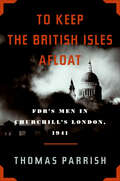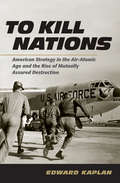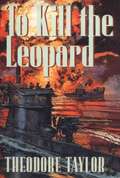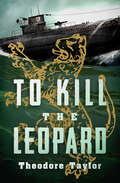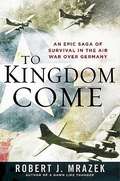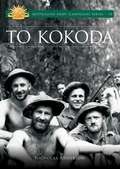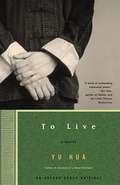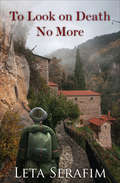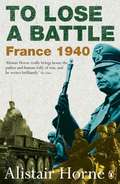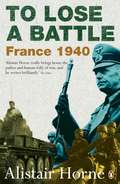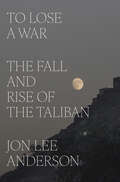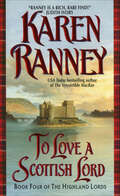- Table View
- List View
To Glory We Steer (Richard Bolitho #5)
by Alexander KentRichard Bolitho takes command of the frigate Phalarope, whose crew is discredited by a near-mutiny and suspected cowardice, and sails to the West Indies during the final years of the American Revolution. The crew is welded into an effective cadre during a battle with French forces. Sequel to Sloop of War.
To Guard Against the Dark (Reunification #3)
by Julie E. CzernedaThe final book in the hard science fiction Reunification trilogy, the thrilling conclusion to the award-winning Clan ChroniclesJason Morgan is a troubling mystery to friends and enemies alike: once a starship captain and trader, then Joined to the most powerful member of the Clan, Sira di Sarc, following her and her kind out of known space.Only to return, alone and silent. But he's returned to a Trade Pact under seige and desperate. The Assemblers continue to be a threat. Other species have sensed opportunity and threaten what stability remains, including those who dwell in the M'hir. What Morgan knows could save them all, or doom them. For not all of the Clan followed Sira. And peace isn't what they seek.
To Hanoi And Back: The United States Air Force And North Vietnam 1966-1973 [Illustrated Edition]
by Dr Wayne ThompsonIncludes 3 maps and 40 photographsNo experience etched itself more deeply into Air Force thinking than the air campaigns over North Vietnam. Two decades later in the deserts of Southwest Asia, American airmen were able to avoid the gradualism that cost so many lives and planes in the jungles of Southeast Asia. Readers should come away from this book with a sympathetic understanding of the men who bombed North Vietnam. Those airmen handled tough problems in ways that ultimately reshaped the Air Force into the effective instrument on display in the Gulf War.This book is a sequel to Jacob Van Staaveren's Gradual Failure: The Air War over North Vietnam, 1965-1966, which we have also declassified and are publishing. Wayne Thompson tells how the Air Force used that failure to build a more capable service-a service which got a better opportunity to demonstrate the potential of air power in 1972.Dr. Thompson began to learn about his subject when he was an Army draftee assigned to an Air Force intelligence station in Taiwan during the Vietnam War. He took time out from writing To Hanoi and Back to serve in the Checkmate group that helped plan the Operation Desert Storm air campaign against Iraq. Later he visited Air Force pilots and commanders in Italy immediately after the Operation Deliberate Force air strikes in Bosnia. During Operation Allied Force over Serbia and its Kosovo province, he returned to Checkmate. Consequently, he is keenly aware of how much the Air Force has changed in some respects-how little in others. Although he pays ample attention to context, his book is about the Air Force. He has written a well-informed account that is both lively and thoughtful.
To Hanoi and Back
by Richard P. Hallion Wayne ThompsonAfter nearly eighteen months of the largely unsuccessful bombing campaign called Operation Rolling Thunder, the US Air Force began to look for ways to overcome technological, geographical, and political challenges in North Vietnam and use limited air power more effectively. In 1972 the two Linebacker campaigns joined with other air operations to make a dramatic, although temporary, difference. While they unleashed powerful B-52 area bombers, the campaigns also demonstrated the efficacy of newly developed laser-guided precision bombs.Drawing upon twenty years of research in classified records, Wayne Thompson integrates operational, political, and personal detail to present a full history of the Air Force role in the war against North Vietnam. He provides an unprecedented view of the motivations and actions of the people involved--from aircrews to generals to politicians--in every phase of the air campaigns. He outlines, for instance, the political reasons for President Johnson's reluctance to use B-52 bombers against major North Vietnamese targets. He also examines how the media influenced US policy and how US prisoners became the war's most celebrated heroes.The war in Southeast Asia ultimately pushed the Air Force toward adopting more flexible tactics and incorporating increasingly sophisticated weapons that would shape later conflicts.
To Have a Husband (Bachelor Sisters Ser. #1)
by Carole MortimerAn Englishman struggles to break up a wealthy woman and a deceptive blackmailer in this contemporary romance by a USA Today–bestselling author.Harrie Summer had no choice but to spend time—too much time—with the arrogant Quinn McBride, who was determined to stop the blackmailer in his tracks. Harrie didn’t know if she could trust or believe Quinn; the only thing she was sure about was that, no matter how hard she fought against it, she found him incredibly attractive. . . .Originally published in 2014.
To Hell and Back: Europe 1914-1949 (The Penguin History of Europe)
by Ian KershawThe Penguin History of Europe series reaches the twentieth century with acclaimed scholar Ian Kershaw's long-anticipated analysis of the pivotal years of World War I and World War II. The European catastrophe, the long continuous period from 1914 to 1949, was unprecedented in human history--an extraordinarily dramatic, often traumatic, and endlessly fascinating period of upheaval and transformation. This new volume in the Penguin History of Europe series offers comprehensive coverage of this tumultuous era. Beginning with the outbreak of World War I through the rise of Hitler and the aftermath of the Second World War, award-winning British historian Ian Kershaw combines his characteristic original scholarship and gripping prose as he profiles the key decision makers and the violent shocks of war as they affected the entire European continent and radically altered the course of European history. Kershaw identifies four major causes for this catastrophe: an explosion of ethnic-racist nationalism, bitter and irreconcilable demands for territorial revisionism, acute class conflict given concrete focus through the Bolshevik Revolution, and a protracted crisis of capitalism. Incisive, brilliantly written, and filled with penetrating insights, To Hell and Back offers an indispensable study of a period in European history whose effects are still being felt today. From the Hardcover edition.
To Hell and Back: The Classic Memoir of World War II by America's Most Decorated Soldier
by Audie MurphyThe classic WWII memoir by America’s most decorated soldier shares a “vivid, gripping, mature picture of combat” (The New York Times Book Review).Originally published in 1949, To Hell and Back was a bestselling phenomenon and later became a major motion picture starring Audie Murphy as himself. It remains one of the most harrowing personal narratives of the Second World War and a perennial classic of military nonfiction.Rejected from both the marines and the paratroopers because he was too small, Murphy was desperate to see action and determined to serve his country. Eventually, he found a home with the infantry and fought through campaigns in Sicily, Italy, France, and Germany. Although still under twenty-one years old on V-E Day, he was credited with having killed, captured, or wounded 240 Germans. He emerged from the war as America’s most decorated soldier, having received twenty-one medals, including our highest military decoration, the Congressional Medal of Honor.
To Hell and Back: True Life Experiences of Bomber Command at War
by Mel RolfeThe author of Flying into Hell climbs into the cockpit with the pilots of Bomber Command for classic stories of gallantry in World War II. This new edition of Mel Rolfe&’s successful book contains twenty dramatic but true stories of Bomber Command adventures. Some of them defy belief—like the RAF bomb aimer who was blown out of his Liberator over Warsaw at 400ft without a parachute and made a poignant return in 1989 to witness the unveiling of a memorial on the crash site. Others defy logic—like two men of the same crew who survived a terrible crash, neither aware of the other&’s existence but both saved by the tolling of the same church bell. All are riveting. A journalist by profession, Rolfe has conducted his interviews and prepared the stories in such a way as to take the reader into the events as they happened. To read these accounts is to step back into the war itself.
To Keep The Ship
by A. Bertram ChandlerJohn Grimes falls into the clutches of terrorists. Its going to talk all his efforts to keep his precious golden ship. (Especially as it is infected with mini-Susies who were sharp-toothed, hungry and ready to eat him alive.)
To Keep The Ship (John Grimes)
by A. Bertram ChandlerJohn Grimes falls into the clutches of terrorists. Its going to talk all his efforts to keep his precious golden ship. (Especially as it is infected with mini-Susies who were sharp-toothed, hungry and ready to eat him alive.)
To Keep the British Isles Afloat: FDR's Men in Churchill's London, 1941
by Thomas Parrish“Thomas Parrish’s account of Anglo-American relations in 1941 is a carefully researched and deftly written slice of history showing FDR’s hidden hand at work. It is a lesson on the virtues of diplomacy.” — Ted Morgan, author of CHURCHILLParrish’s book brings Hopkins and Harriman vividly to life--each was indeed a character, and the author’s perception of FDR’s thinking is exceptionally sensitive. For historians most useful. For the rest of us a very good read, a page turner for me. — Curtis Roosevelt, author of TOO CLOSE TO THE SUN: Growing Up in the Shadow of my Grandparents, Franklin and Eleanor“A vivid portrait of crucial maneuverings in the most crucial yet little-noted of years, Thomas Parrish’s new book…offers a fresh look at how Churchill’s Britain survived while Roosevelt’s America moved ever so slowly toward forming what became the Grand Alliance.” — Jon Meacham, author of FRANKLIN AND WINSTON“In an engaging, and authoritative voice, Thomas Parrish vividly depicts Harry Hopkins and Averell Harriman, and delineates their crucial role in saving Great Britain and, thus, America during the early part of World War II. This book shines a new light on Franklin Roosevelt and his partnership with Winston Churchill” — Will Swift, author of THE KENNEDYS AMIDST THE GATHERING STORM“Plays a valuable role in highlighting an often overlooked period of the Second World War, after the Battle of Britain but before Pearl Harbor, when President Roosevelt struggled to find and implement a policy of all possible material aid and support short of American military involvement and war. — Alan Packwood, Director, The Churchill Archives Centre“Parrish is a skilled writer, adept at conveying an authentic sense of the prevailing atmosphere...1941 is the compelling story here, now illuminated by this account of the successful efforts of two pathfinding American statesmen to help bring the liberal democracies together.” — Fraser Harbutt, Department of History, Emory University, author of The Iron CurtainParrish, the author of several books about World War II, uses Clare Booth to back into his thesis that a sleepy, isolationist America needed to be roused, and that Roosevelt relied on two remarkable men – Hopkins and Harriman – to help sound the alarm and secure aid for Britain. — New York Times Book Review
To Kill Nations: American Strategy in the Air-Atomic Age and the Rise of Mutually Assured Destruction
by Edward KaplanBetween 1945 and 1950, the United States had a global nuclear monopoly. The A-bomb transformed the nation’s strategic airpower and saw the Air Force displace the Navy at the front line of American defense. In To Kill Nations, Edward Kaplan traces the evolution of American strategic airpower and preparation for nuclear war from this early air-atomic era to a later period (1950–1965) in which the Soviet Union’s atomic capability, accelerated by thermonuclear weapons and ballistic missiles, made American strategic assets vulnerable and gradually undermined air-atomic strategy. The shift to mutually assured destruction (MAD) via general nuclear exchange steadily took precedence in strategic thinking and budget allocations. Soon American nuclear-armed airborne bomber fleets shaped for conventionally defined—if implausible, then impossible—victory were supplanted by missile-based forces designed to survive and punish. The Air Force receded from the forefront of American security policy.Kaplan throws into question both the inevitability and preferability of the strategic doctrine of MAD. He looks at the process by which cultural, institutional, and strategic ideas about MAD took shape and makes insightful use of the comparison between generals who thought they could win a nuclear war and the cold institutional logic of the suicide pact that was MAD. Kaplan also offers a reappraisal of Eisenhower’s nuclear strategy and diplomacy to make a case for the marginal viability of air-atomic military power even in an era of ballistic missiles.
To Kill the Leopard
by Theodore TaylorAn account of the hunt for the elusive leopard U-boat as told from both the Allied and German sides.
To Kill the Leopard
by Theodore Taylor&“A high-impact techno-thriller [that] brings readers into the heart of WWII&’s Battle of the Atlantic . . . To Kill the Leopard is a winner.&” —Publishers Weekly The U-boat under Horst Kammerer&’s command bears a leopard insignia, and Kammerer is indeed a feral hunter as he torpedoes Sully Jordan&’s oil tanker. The merchant marine escapes with his life—only to encounter Kammerer again a month after Pearl Harbor. After Jordan loses yet another ship to the German captain, he boards a Q-ship—a decoy packed with weapons—with the intention of becoming predator instead of prey . . . &“The novel sustains interest from first page to last with an exciting story line that climaxes in an enthralling final duel.&” —Publishers Weekly &“Realistic submarine suspense . . . Leaps from scenes aboard a Nazi U-boat to scenes on freighters sailed by American merchant mariner Sully Jordan to scenes in Lorient, France, where the Resistance works against the Occupation.&” —Kirkus Reviews
To Kingdom Come
by Robert J. MrazekThe breathtaking, never-before-told, true story of a historic air force bombing mission in 1943 Germany.
To Kingdom Come
by Robert J. MrazekOn September 6, 1943, three hundred and thirtyeight B-17 "Flying Fortresses" of the American Eighth Air Force took off from England, bound for Stuttgart, Germany, to bomb Nazi weapons factories.Dense clouds obscured the targets, and one commander's critical decision to circle three times through heavy fire would prove disastrous. Forty-five planes went down that day, and hundreds of men were lost or missing.Sharing the first-person accounts of six of the B-17 airmen, award- winning author Robert J. Mrazek vividly re-creates the fierce air battle-and reveals the astonishing valor of the airmen who survived being shot down, and the tragic fate of those who did not.
To Kokoda (Australian Army Campaigns Series #14)
by Nicholas AndersonWhen the Japanese war machine swept through South-East Asia in early 1942, it was inevitable that conflict would reach Australian territory on the island of New Guinea. The ultimate Japanese target was Port Moresby. Conquering the capital would sever communication between Australia and her American ally and allow Japanese air power to threaten Australia&’s northern cities. When a seaborne invasion was thwarted at the Battle of the Coral Sea, the Nankai Shitai landed in Papua on 21 July and lunched an overland attack. Having captured the village of Kokoda with its vital airstrip, the Japanese headed for Port Moresby, traversing the treacherous Kokoda trail that winds across the might Owen Stanley Range. The Australian Army was ill prepared to confront the Japanese. Poorly equipped, undertrained, and unaccustomed to jungle warfare, the untested militia battalions were the first to face the battle-hardened invading forces. Later, when veteran AIF brigades were rushed forward to bolster the militia, they also fell in the path of the Japanese onslaught. But the over-extension of supply lines and disaster on Guadalcanal eventually cruelled Japanese aspirations and the Kokoda campaign became a bloody and protracted struggle as the Australian troops fought to drive the Japanese off the Owen Stanleys and out of Papua. While the front-line troops were engaged in a bitter fight for survival, a power struggle erupted at the top of the Allied command hierarchy resulting in a series of sackings, the competing ambitions of the Allied commanders clouding their judgement at a critical time. It was under these conditions, against a determined enemy and on one of the harshest battlefields on earth, that the Australian forces began to learn the crucial lessons that would be needed to break the back of the Japanese Army in New Guinea.
To Live: A Novel
by Yu HuaOriginally banned in China but later named one of that nation&’s most influential books, a searing novel that portrays one man&’s transformation from the spoiled son of a landlord to a kindhearted peasant. &“A work of astounding emotional power.&” —Dai Sijie, author of Balzac and the Little Chinese SeamstressFrom the author of Brothers and China in Ten Words: this celebrated contemporary classic of Chinese literature was also adapted for film by Zhang Yimou. After squandering his family&’s fortune in gambling dens and brothels, the young, deeply penitent Fugui settles down to do the honest work of a farmer. Forced by the Nationalist Army to leave behind his family, he witnesses the horrors and privations of the Civil War, only to return years later to face a string of hardships brought on by the ravages of the Cultural Revolution. Left with an ox as the companion of his final years, Fugui stands as a model of gritty authenticity, buoyed by his appreciation for life in this narrative of humbling power.
To Look on Death No More
by Leta SerafimDuring WWII, an Irish allied soldier in Greece finds love for a woman, and for a people, as he joins in their tragic fight against the Nazis. In autumn of 1943, a lone allied soldier parachutes into Greece. His stated goal: to build an airstrip for the British. Brendon O'Malley is an Irishman, and though the Nazis are his enemy, that doesn’t necessarily make the British his friends—especially when he discovers they have seriously misled him about his mission. Wounded during the drop, he's set upon and robbed by seventeen-year-old Danae and her little brother, Stefanos. Mistrustful of any foreigner, the two hold him captive in their home in the village of Kalavryta. But despite the mistrust, a wary friendship develops between the three—especially between Brendon and Danae. After his wounds heal, Brendon even joins the Greek resistance, the antartes. But disaster lies just ahead, and the Nazis, already a palpable presence in their lives, stage a savage attack on Kalavryta. Through it all, the love that has grown between Brendon and Danae cannot be extinguished.
To Lose a Battle: France 1940
by Alistair HorneTo Lose a Battle: France 1940 is the final book of Alistair Horne's trilogy, which includes The Fall of Paris and The Price of Glory and tells the story of the great crises of the rivalry between France and Germany. In 1940 Hitler sent his troops to execute the Fall of France. A six-week battle with lightning 'blitzkrieg' warfare and combined operations techniques, the offensive ended the Phony War and sent the French forces reeling as their government fled from occupied Paris. For the Axis, it was a dramatic victory. But how was this spectacular result possible? In To Lose a Battle Alistair Horne tells the day-by-day, moment-by-moment story of the battle, sifted from the vast Nazi archives and the fragmentary records of the beaten Allies. Using eye-witness accounts of battle operations and personal memoirs of leading figures on both sides, this book steps far beyond the confines of military accounts to form a major contribution to our understanding of this important period in European history. 'Alistair Horne really brings home the pathos and human folly of war, and he writes brilliantly' The Times 'Horne follows his line unfalteringly. All the details are there: the small, fleeting triumphs, the greater disasters, the bravery, the cowardice, the stupidity and the intelligence ... that make war so fascinating and so terrible' Economist 'Horne completes his masterly trilogy ... the definitive account of one of the most efficient and astonishing campaigns of all time' The Times Literary Supplement One of Britain's greatest historians, Sir Alistair Horne, CBE, is the author of a trilogy on the rivalry between France and Germany, The Price of Glory, The Fall of Paris and To Lose a Battle, as well as a two-volume life of Harold Macmillan.
To Lose a Battle: France 1940
by Alistair HorneIn 1940, the German army fought and won an extraordinary battle with France in six weeks of lightning warfare. With the subtlety and compulsion of a novel, Horne’s narrative shifts from minor battlefield incidents to high military and political decisions, stepping far beyond the confines of military history to form a major contribution to our understanding of the crises of the Franco-German rivalry.To Lose a Battle is the third part of the trilogy beginning with The Fall of Paris and continuing with The Price of Glory (already available in Penguin).
To Lose a War: The Fall and Rise of the Taliban
by Jon Lee AndersonFrom one of the great foreign correspondents of our time, author of some of the most essential reporting from Afghanistan from before 9/11 to the return of the Taliban to power in 2021, the first full accounting of that entire era, combining previously published dispatches and new reporting into a single epic tapestryJon Lee Anderson first reported from Afghanistan in the late 1980s, covering the US-backed mujahideen&’s insurrection against the Soviet-backed regime in Kabul. Within days of the 9/11 attacks, he was again on the ground as an early eyewitness to the new war launched by the US against the Taliban and their Al Qaeda allies. His reportage from the first year of the war won a number of awards and was published in book form as The Lion&’s Grave: Dispatches from Afghanistan. At the time, the American military had prevailed on the battlefield, and the newfound peace seemed to offer a precious space for Afghan society to restore itself and to forge a democratic future. But all was not well: Osama bin Laden was still in hiding, the Taliban were stealthily reorganizing for a comeback, and the United States was about to turn its attention to Iraq. To Lose a War collects Anderson&’s writing from Afghanistan over a near-quarter-century span. Containing the stories from The Lion&’s Grave and all of those he published since, as well as important writing appearing here for the first time, the book offers a chronological account of a monumental tragedy as it unfolds. The colossal waste, missed signals, and wishful thinking that characterized the twenty-year arc of the US-led war in Afghanistan have consecrated it as one of the greatest foreign policy failures of the modern era, and a bellwether of a larger American imperial decline.
To Lose the Earth (Star Trek: Voyager)
by Kirsten BeyerThe long-awaited follow-up to Voyager: Architects of Infinity from the New York Times bestselling author and cocreator of Star Trek: Picard! As the crew of the Full Circle fleet works to determine the fate of their lost ship, the Galen, a struggle for survival begins at the far edge of the galaxy. New revelations about Species 001, the race that built the biodomes that first drew the fleet to investigate planet DK-1116, force Admiral Kathryn Janeway to risk everything to learn the truth.
To Love Again: An epic, unputdownable read from the worldwide bestseller
by Danielle SteelTHE WORLD'S FAVOURITE STORYTELLER NEARLY ONE BILLION COPIES SOLD Isabella and Amadeo. The toast of international society and the undisputed leaders of Rome couture. Together they ruled the House of San Gregoria, a monument to Isabella's fabulous designs and stunning beauty, to Amadeo's unerring flair and golden Florentine elegance. And beyond their enchanted world of splendour shone their boundless, undying love for one another.Then suddenly their dream was shattered. Amadeo was gone - for ever. Isabella fled to Rome for a new life of bitter struggles and haunting memories. With her proud courage and all her zest for living, could she ever say goodbye to the past and dare . . . to love again.An epic and romantic tale from one of the best-loved writers of all time. Perfect for fans of Penny Vincenzi, Lucinda Riley and Maeve BinchyPRAISE FOR DANIELLE STEEL:'Emotional and gripping . . . I was left in no doubt as to the reasons behind Steel's multi-million sales around the world' DAILY MAIL'Danielle Steel is undeniably an expert' NEW YORK TIMES
To Love a Scottish Lord: Book Four Of The Highland Lords (The Highland Lords #4)
by Karen RanneyA Lord Not Meant to MarryHamish MacRae, a changed man, returned to his beloved Scotland intending to turn his back on the world. The proud, brooding lord wants nothing more than to be left alone, but an unwanted visitor to his lonely castle has defied his wishes. While it is true that this healer, Mary Gilly, is a beauty beyond compare, it will take more than her miraculous potions to soothe his wounded spirit. But Mary's tender heart is slowly melting Hamish's frozen one . . . awakening a burning need to keep her with him -- forever.A Lady Who Dares Not LoveNever before has Mary felt such an attraction to a man! The mysterious Hamish MacRae is strong and commanding, with a face and form so handsome it makes Mary tremble with wanting him. Already shadowy forces are coming closer, heartless whispers and cruel rumors abound, and it will take a love more pure and powerful than any other to divine the truth -- and promise a future neither had dreamed possible.
